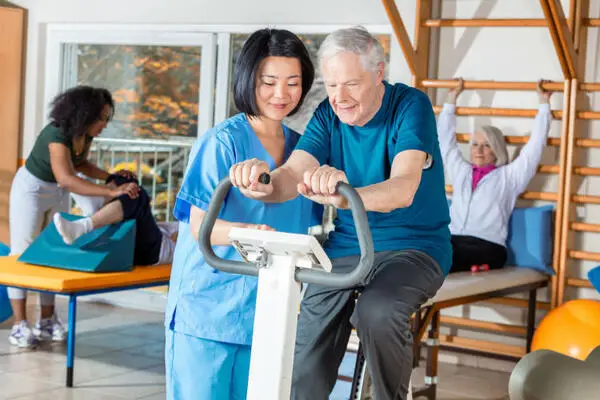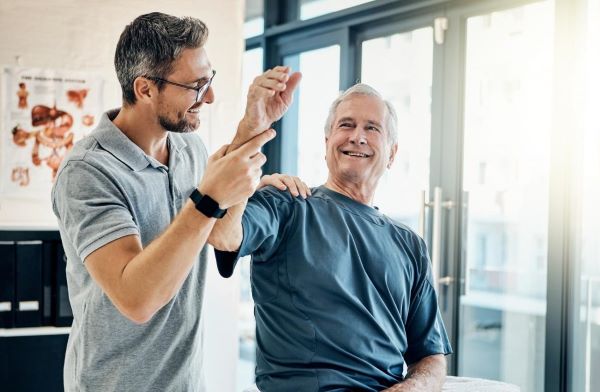
What is the Difference Between Physical and Occupational Therapy?
Do you have a parent or loved one that has a difficult time completely daily tasks? You may have tried to help them with these tasks but were unsuccessful. If so, it may be beneficial to check with their doctor to see if physical and/or occupational therapy might be a good option for them. These two therapies involve going to appointments based on their needs to work on special movements and adaptations to help them become stronger and learn new ways to complete activities of daily living. If you're wondering which of these therapies might be a good fit for your family members needs, keep reading to learn about the differences between physical therapy and occupational therapy.
What is Physical Therapy?
Physical Therapy (PT) is a type of treatment that is used to ease pain and help your body move and function better. Physical therapy will generally be recommended by doctors if a patient has an injury or low functionality in a certain area of the body that makes it difficult to complete daily tasks. This treatment is popular for the senior age population due to health issues that may arise.
Physical Therapy Can Be Used For: 
- Pain Relief
- Improving body moment
- Recovering from or preventing an injury
- Rehabilitation after a stroke or surgery
- Working on balance to prevent falls
- Bowel or bladder control
- Adaptation to an artificial limb
- Getting a brace or splint
When going to a physical therapist you will be evaluated based on the condition you have, and a plan will be outlined to help guide your therapy. Each part of the body has special exercises and stretches to help with movement and function. Depending on what you're being seen at the PT for, your physical therapist and doctor may work together on a plan for treatment. Your plan will include small goals to work towards your overall larger goal. The amount of visits you will attend PT will vary greatly depending on the reason for your treatment.
Possible Treatments Done During Physical Therapy
- Exercises and stretches
- Massage
- Heat or cold therapy
- Water therapy
- Practice with objects such as cane or walker
What is Occupational Therapy?
Occupational Therapy (OT) although similar in some aspects, is different than physical therapy. Physical therapy and occupational therapy can both focus on pain relief and healing from an injury, however OT helps individuals with performing daily activities. These activities can include daily chores, ADLs, or participating in any other activity that may be difficult. Occupational therapy teaches you how to adapt and can also teach you how to use assistive devices.
Occupational Therapy Can Be Used For: 
- Eating without help from others
- Participating in leisure activities (walking, golfing, knitting, bowling etc.)
- Bathing
- Getting dressed
- Doing chores (laundry, cooking, cleaning)
- Working on fine motor skills (picking up a pencil, buttoning a shirt, tying shoes etc.)
- Working on hand-eye coordination
- Using assistive devices (raised toilet seat, grabber tool, cane, wheelchairs etc.)
- Preventing falls in home or public
Occupational therapists look at how you perform a task and come up with treatment plans on how to help you perform that task easier and more comfortably. Occupational therapists will train you to adapt your movements, improve your motor skills or hand-eye coordination, and/or perform tasks in new and different ways.
What are ADLs?
ADL stands for activities of daily living which represents the daily life activities that people manage in order to live independently. These activities require a certain amount of physical capability in order to successfully complete them. As we get older we start to lose some of the functionality in our joints and muscles. This can cause difficulty in completing ADLs successfully.
Examples of ADLs include:
- Ambulating: The ability of someone getting around the home or outside of the home. This can be walking, either independently or with assistance such as a cane, walker, or wheelchair
- Transferring: Being able to move your body from one place to another. For example, sitting down on the couch and getting up or getting in and out of bed
- Feeding: Getting food from the plate in ones mouth
- Dressing/Grooming: Choosing clothes, putting them on, and otherwise maintaining a health and clean appearance
- Bathing: Washing ones face and body in a bath or shower
- Toileting: Getting to and from the bathroom, using the toilet appropriately, and cleaning oneself
Being able to complete ADLs with the use of OT and PT will keep you living independently for a longer period of time.
How Can Seniors Benefit from OT and PT?
Seniors can benefit greatly from occupational and physical therapy treatments. With age sometimes it can get more difficult to complete activities of daily living because of health issues such as arthritis or maybe an injury. Physical therapy can help seniors relieve some of the pain caused by their health problem which can make it easier to complete these activities. Mixing OT with PT would be beneficial because once the discomfort or pain is minimized and the movement is maximized, OT can help teach you to learn new and adaptive ways to complete activities of daily living. Being able to complete these tasks will keep you more independent for a longer period of time. There are many places that offer PT and OT treatment conveniently for seniors. Some of these may be in senior living facilities, hospitals, independent local offices, rehab centers and many more.
Bottom Line
Everyone wants to stay as independent as they can for as long as possible. Participating in OT and/or PT may help you maintain this independence while helping you physically feel better. There are many places that offer these therapies for seniors to easily participate. If you think this sounds like something that would be helpful if you or your family members life, make sure to check with their doctor first and find a place that is a good fit for you.